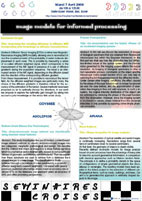|
SEMINAIRE CROISE
Ariana - Asclépios - Odyssée
7 avril 2009 à 10h
Salle Euler Violet |
 |
format des présentations : 30mn +5mn de questions
Chair :
10h00 : Introduction
Emmanuel Caruyer
Odyssée
" Improving the sampling efficiency in diffusion MRI incorporating prior knowledge on diffusion characteristics"
Diffusion Tensor Imaging (DTI) is a rather new Magnetic
Resonance Imaging (MRI) modality, allowing one to reconstruct in
vivo the covariance matrix of the probability of water molecules
displacement in each voxel. This is possible by measuring a series
of so-called diffusion weighted signal, which corresponds to the
measurement of the MR signal in presence of a pair of diffusion
gradients during the acquisition sequence. The result is an
attenuated version of the MR signal, depending on the diffusion
speed into the direction of the corresponding diffusion gradient.
From these measurement, it is possible to reconstruct the tensor
field. As the diffusion weighted images are particularly noisy, the
choice of the diffusion gradients is therefore critical for the
accuracy of the estimation of the tensor. Several methods have been
proposed so far to optimally choose the directions, in our work we
propose to explore the optimality gain brought by taking into
account a prior knowledge on the tensor field under study.
Praveen Pankajakshan
Ariana
" On deconvolution and the hidden "Phase" of an incoherent imaging system"
In this talk we discuss the restoration of images of biological specimens that are obtained from fluorescent microscopes but within the Bayesian framework. In the first part we shall see how the aberration-free but diffraction-limited nature of the optical system and the intrinsic noise generated by the imaging system affects the output resolution. As imaging of biological specimens is often a non-repeatable process, constraints on the object and the microscope Point-spread function (PSF) can only help in restoring the lost frequencies beyond the diffraction limits.
Under certain other imaging conditions, the effect caused by the phase of the pupil function can no longer be ignored (as was the case before), and the approximation of aberration-free imaging is thus not valid anymore. In such a situation, the original intensity distribution of the object can be estimated by retrieving the phase of the pupil function from the observation. However, since the imaging system is incoherent in nature, phase retrieval from the observed intensities is only possible by applying some simple physical constraints.
Barbara André
Asclepios and Mauna Kea Technologies
"Endomicroscopic image retrieval and classification using invariant visual features"
This study investigates the use of modern content based
image retrieval methods to classify endomicroscopic images into two
categories: neoplastic (pathological) and benign. We describe first
the method that maps an image into a visual feature signature which
is a numerical vector invariant with respect to some particular
classes of geometric and intensity transformations. Then we explain
how these signatures are used to retrieve from a database the k
closest images to a new image. The classification is finally
achieved through a procedure of votes weighted by a proximity
criterion (weighted k-nearest neighbors). Compared with several
previously published alternatives whose maximal accuracy rate is
almost 67% on the database, our approach yields an accuracy of 80%
and offers promising perspectives."
Maria Kulikova
Ariana
"Shape recognition for image analysis "
The resolution of optical satellite and aerial images is continually increasing. Resolutions range from several tens of centimeters down to several centimeters.
At that level, the geometry of objects is clearly visible.
Recently defined stochastic models for image analysis based on point processes have the advantage of being able to take into account geometrical information, in comparison with classical approaches such as Markov random fields. The principle is to define a probabilty density in the space of configurations of simple geometrical objects like discs, ellipses or rectangles. The resulting models have been applied in the Ariana project to the extraction of different carthographical items, such as roads, buildings, and trees. Our aim is to generalize this approach to arbitrarily shaped objects in the image.
Discussions
12h30 : Fin du séminaire
|





